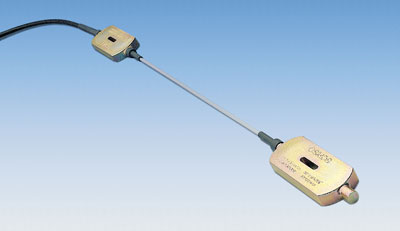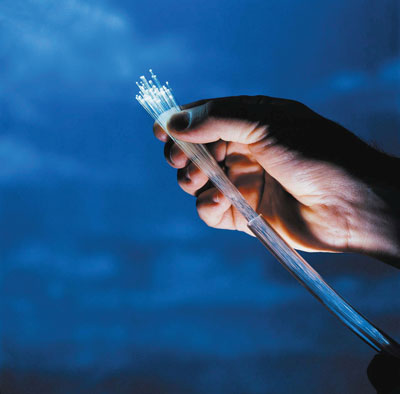
Features
Business intelligence
Contracting
Shining a light on structure
Optical measurement technology promises a new era of structural analysis.
August 20, 2012 By Louis Crepeau
Founded in 2001, Groupe OSMOS is a world leader in fibre-optic technology solutions for the monitoring of structural integrity.
Founded in 2001, Groupe OSMOS is a world leader in fibre-optic technology solutions for the monitoring of structural integrity. OSMOS holds over 50 international patents, counts more than 1,000 successfully completed projects and continues to be active in all areas of structural engineering. OSMOS has been represented in Canada since 2005.

|
|
Due to a lack of suitable process technology, insufficient consideration has been paid to the time factor in structural monitoring. Such time cycles as seasons, weekdays and weekends, day and night, high and low tides, drive-shaft rotation and natural oscillations leave their marks on a structure. These cycles can range in duration from a few fractions of a second to several years, and usually overlap.
Optical measuring systems, such as those developed by OSMOS Canada, permit complete and continuous structural diagnostics. They register the entire history of a structure to allow comprehensive analyses. This is achieved through continuous recordings of such static and dynamic stress cycles as tensions, deformations and displacements. Even in the event of a power failure, the integrated reference variable prevents a loss of orientation, thus permitting a correct resumption of recording of measured data following a restoration of power.
OSMOS Canada has harnessed optical-waveguide technology to allow measurements of structural changes. The OSMOS Canada measuring system is based on the principle of intensity modulation with analog attenuation measurement, which was selected following an examination of all fibre-optic techniques of detecting changes in shape and position. This technique provides extremely stable and reliable solutions with an optimized cost/performance ratio and minimized requirements for electronic and mechanical components. Connecting the sensors via standard optical cables permits measurement signals to be transmitted over long distances without the need for conversion or intermediate amplification.
OSMOS developed the monitoring station for precise registration of the signals supplied by the fibre-optic sensors. This station consists of a master unit, which performs all the necessary network functions, and a slave unit, which performs data measurement. The measured data are fetched and managed by the master unit. The connection between the master and slave is established via a bus (RS 485).
The entire system can be configured online with a web server, or offline using an editor. A database server establishes a modem connection with all configured measurement points and archives all raw data and configuration data accumulated since the previous connection. With the help of the configuration data, all raw data on the database server are converted into measurement data and visualized. Access is controlled by means of a password.
Measured values can be displayed on XY graphs or as dashboards (threshold values with alarm levels). Maximum and minimum values for each day and for the current measurement period are displayed. The measured data can also be exported for further processing (jpeg, bmp, ASCII table).
Individual measurement values are scanned at a rate of 100 Hertz. An average value – the raw measurement value – is formed from these individual values over a configured measurement interval of 10 to 1,000 milliseconds and saved in a memory with a depth of 300 locations. The raw measurement data form the basis for calculating measurement values.
The memory contains raw measurement data (attenuation and temperature) as well as measurement values (expansion and displacement). These values are used to continuously form the static average value. The static interval can range from 100 seconds to one day. Daily static average values are then saved in a file.
Dynamic data on structural changes in monitored buildings are registered continuously by the OSMOS system and saved for evaluation on reaching specified threshold values. Static data are averaged on the basis of these dynamic data and saved. Static behaviour is therefore the integral function of dynamic behaviour. This permits a formulation of multi-functional statements concerning the objects to be monitored.
- Optical measuring systems can provide:
- Ongoing risk surveillance to ensure safety of building structures
- Optimized investment and reduced maintenance costs
- Early detection of defects
- Quality assurance during construction work
- Precise information for developing clear action plans
- Necessary data to define and lay down preventive measures
- Detection of latent defects
Sporadic measurements on structures provide data at apparently important points in time. These random data acquisitions are used as a basis for drawing conclusions that can be highly erroneous.
Consequently, this type of data acquisition is not suitable for reliable forecasts concerning structural behaviour. Knowledge of the entire history of a structure makes it possible to identify and analyze periodic events. This permits a better evaluation of the acquired data. As the period of observation lengthens, an increasing amount of knowledge becomes available to the user, thus resulting in a continuous learning curve. This allows qualified forecasts of future structural behaviour as well as precise risk estimates. Structures can be observed objectively. Only a continuous monitoring of structural loads and stress cycles reflects actual structural characteristics.
Engineering, preventive management and infrastructures monitoring are the wave of the future. Optical measurement technology makes it possible to carry out a snapshot of ongoing works in order to determine a structure’s state, integrity and external influences. It then becomes possible to predict appropriate action to be taken at the right time and the right cost, while ensuring the safety of users and making possible the prolonged useful life of the structure.
OSMOS’s optical technology is the only option for measuring the static and dynamic effects of any type of structure with the same equipment. One can foresee the controlled structural integrity. Unlike theoretical models, optical monitoring makes it possible to determine how structures really do evolve rather than how they should evolve. This allows for proper risk management decision making before major catastrophic consequences occur.
Over the years, OSMOS Group has applied optical monitoring technology in a number of fields, including roads, bridges, railways, industrial structures, historic buildings, hydraulic engineering projects, towers, wind turbines, geotechnical structures, underground infrastructures and large commercial and residential buildings. OSMOS Canada is presently looking for partners to test this technology in a curtain wall application.
How does optical measurement work?
Fibre-optic cable transmits light by bouncing light rays off the walls of its highly reflective interior. When the cable is straight, the light rays hit the internal walls of the cable at a low angle, allowing the light to quickly get from one end to the other. When the cable is bent, the rays hit the reflective walls at a higher angle and therefore have to travel farther to get through the same length of cable. By measuring the time it takes for light to get from one end to the other, a computer can calculate the amount of deflection the cable is experiencing. Strain on a structure can be measured in terms of the amount of deflection the structure experiences away from its normal position. Depending how the cables and sensors are mounted, they can detect bending, twisting, bulging, shrinking or growth. By measuring how the structure’s deflection changes over time, optical measuring devices can measure vibration. |
Print this page

Leave a Reply